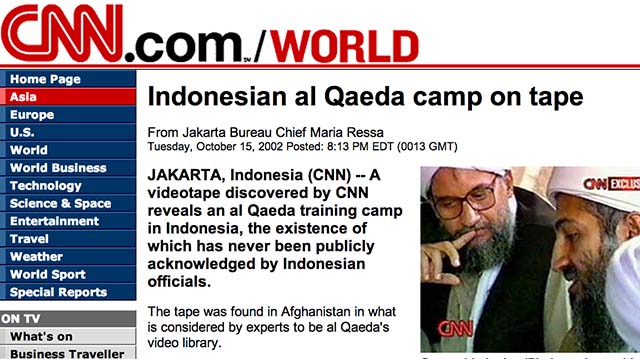SUMMARY
This is AI generated summarization, which may have errors. For context, always refer to the full article.
 When the Chechen roots of Boston bombing suspects Tamerlan and Dzhokhar Tsarnaev became public, it threw me back in time to the end of September 2002 when I delved into Chechnya’s links to al-Qaeda’s global jihad.
When the Chechen roots of Boston bombing suspects Tamerlan and Dzhokhar Tsarnaev became public, it threw me back in time to the end of September 2002 when I delved into Chechnya’s links to al-Qaeda’s global jihad.
I was in a small cubicle on the 6th floor of the North Tower of CNN’s headquarters in Atlanta, Georgia. For nearly a week, I had spent 16 to 18 hours a day wading through 251 videotapes from Osama bin Laden’s personal collection. Afraid they’d be mistaken as members of al-Qaeda, the Afghans who found the tapes buried them again until after the arrival of US troops. Then they dug them up and gave them to CNN’s Nic Robertson and Mark Phillips.
One by one, I shook the sand out of each tape, placed it in the deck and watched the video roll, taking notes I still have today. The video was graphic, at times horrifying and extremely alarming. CNN’s investigative producer in charge of the tapes, Henry Schuster, asked me to go through all of them to look for faces and places from Southeast Asia. I watched everything closely, aware we were seeing this before governments and security agencies.
I found the first video of a training camp in Indonesia as well as many others, which all became part of our investigative series based on the “terror tapes.” It gave new insights into al-Qaeda’s organizational structure, its strategies for training, its tactics and its recruitment methods.

Personally alarming for me was tape 106 on the al-Qaeda registry: it contained my report on Pope John Paul II’s 1995 visit to the Philippines. It was chilling to know Osama bin Laden watched the way his plots played out on media, perhaps laughing at the naiveté of journalists.
All this came rushing back when I heard “Chechnya” because that conflict appeared numerous times in bin Laden’s tape collection. Looking back at my notes, I found at least 11 tapes which focused extensively on Chechnya. Tape 135 shows Arab fighters in Chechnya ambushing a Russian convoy – suggesting the cameraman was shooting from the perspective of the Chechen fighters. Several tapes focused on the activities of a key leader, Ibn al-Khattab, who personally met with bin Laden.
Khattab is killed
Chechnya is a predominantly Muslim region in the North Caucasus where insurgents have been fighting for independence since the collapse of the Soviet Union in 1991. In 1994, the first Chechen war began, leading to 2 years of violence as Moscow responded with unbridled brutality.
In 1999, President Vladimir Putin increased Russia’s military presence in Chechnya, triggering the second Chechen war. Moscow says Khattab played a key role in leading Islamic militants in Chechnya’s neighboring region of Dagestan, right around the time the Tsarnaev family moved there.
Like Khattab, other Chechen fighters travelled to Afghanistan and Pakistan to join the global jihad. Chechen militants trained at camps run by al-Qaeda in Afghanistan, and Chechen warlords have been added to the US list of terrorist suspects.
Khattab was killed in 2002, but in 2011, the UN included Doku Umarov, leader of the Caucasus Emirate, to the list of individuals associated with al-Qaeda.
The Boston Marathon bombing is the first time Chechnya has been linked to a terrorist attack in the United States. The reality is Chechen insurgents have largely kept their focus on Moscow, despite the links to and inspiration from al-Qaeda.
There are conflicting reports about where the two brothers were born. Kygryz media, quoting local police, suggest both were born in Kyrgyzstan, but family members said the younger brother, Dzokhar, was born in Dagestan. It seems they never lived in Chechnya but maintained close ties to its culture.
The 26-year-old Tamerlan Tsarnaev was born in 1986. A decade ago, the Tsarnaev family emigrated to the Boston area. Tamerlan may be named after one of history’s most ferocious warlords, a devout Muslim who called himself “the sword of Islam.” Tamerlan seemed to feel disconnected from American life. “I don’t have a single American friend,” he told a photographer. “I don’t understand them.

Tamerlan’s YouTube channel gives a glimpse of what’s important to him, showing his support of fundamentalism and violent jihad. Most alarming is a video about the black flag, which has appeared in violent protests around the world and was discovered by authorities in jihadi camps, including the Abu Sayyaf, in the Philippines.
He deleted two video clips under the label “Terrorists,” which CNN says links to the Caucasus Emirate, the group led by Doku Umarov. That group has significant ties to al-Qaeda, according to a 2011 report by the Center for Strategic and International Studies. “The evidence of the Caucasus Emirate’s integration into global Jihad is overwhelming. Umarov has repeatedly associated the Caucasus Emirate with the global Jihad,” the study said.
On Sunday, April 21, the Caucacus Emirate’s website, the Kavkazcenter.com, denied any links to the Boston bombings. It “declares that the Caucasus fighters are not waging any military activities against the United States of America … we are only fighting Russia, which is not only responsible for the occupation of the Caucasus, but also for monstrous crimes against Muslims.”
Peer-networked world
Events last week show how the threat has mutated since the pinnacle of al-Qaeda’s power – the 9/11 attacks. It shows how the ideology has evolved and how it can infect homegrown young men living in the West through the Internet.
Gone are the days of direct links and centralized commands. Think of this as a bottom-up peer-networked world – each small cell coming together under the strategic goal of a global jihad. You don’t need a big army to make things happen. On social media, for example, you just need a network of peers.
It reminds me of pointillism, the art of painting using small, distinct dots of color which when taken together creates the whole scene. We just need to pull out to see the whole picture.
I still remember Khattab’s face from the tapes I watched closely in 2002. A generation has grown up since then, but what hasn’t changed is how this global jihad continues to entice young recruits for violence. It shows how even without direct links, the conflict in Chechnya can affect America.
The jihadi virus spreads like a medical contagion turning Muslim feelings of injustice into a seed for action. It shows how the Internet can fan the flames leading to terrorist attacks – even without centralized planning or supervision.– Rappler.com
Maria Ressa is the author of “FROM BIN LADEN TO FACEBOOK: 10 Days of Abduction, 10 Years of Terrorism” and “Seeds of Terror: An Eyewitness Account of al-Qaeda’s Newest Center of Operations in Southeast Asia.”
Related Stories:
Boston bombings: When terrorism is a click away
Add a comment
How does this make you feel?
There are no comments yet. Add your comment to start the conversation.